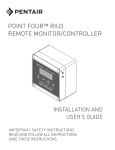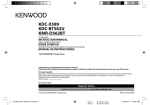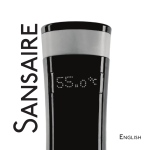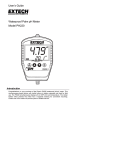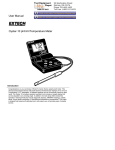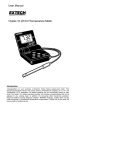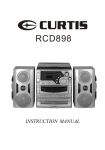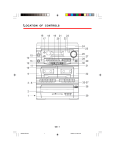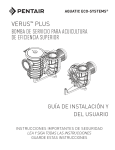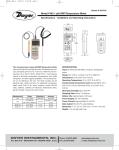Download Waterproof pH/ORP Meter User`s Guide - Pentair Aquatic Eco
Transcript
Waterproof pH/ORP Meter User’s Guide (Model Nos. VS01, VS99) pH ºC pH mV CAL Waterproof pH/ORP/Temp 2395 Apopka Blvd. • Apopka, FL 32703 • Phone: 877-347-4788 • Fax: 407-886-6787 • [email protected] • PentairAES.com Introduction Display Description Congratulations on your purchase of the Vital Sine waterproof pH/mV meter from Pentair Aquatic Eco-Systems. This microprocessor-based device with tactile buttons is battery operated and ideal for field use. The meter simultaneously displays pH or ORP (mV) and temperature. The rubber holster which protects the meter has a magnetic backing for convenient mounting. Careful use of this meter will provide years of reliable service. pH Measurement Units mV Specifications Range (Resolution) Accuracy pH .00 to 14.00 pH (.01pH) ± .02 pH Temperature 32.0 to 212.0ºF (.0 to 99.9ºC) ± .5ºF (.3ºC) mV (ORP) ± 1,999 mV DC (1 mV) ± 2mV 32 to 212ºF (0-100ºC) Automatic (ATC) pH Calibration Points 1.68, 4.00, 7.00, 10.00, 12.45 pH Display Dual LCD for Simultaneous pH or mV and Temperature Readings Over-Range or Open Indication Displays "– – –" for Over-Range or Open Input Power 9-volt Battery Low Battery Indication The Battery Life Indicator ºC ºF Icon Displays No Fill Bars Auto Power Off After 10 Minutes Dimensions/Weight 4.25 x 3.00 x 1.18" (108 x 75 x 30 mm) / .3 lbs (135 g) Accessories Supplied Sample Buffers and Battery Electrode w/39" Cable (VS99) Temperatre Units ATC Temperature Reading Temperature Compensation Automatic Temperature Compensation Calibration pH electrodes are like batteries—they run down with time and use. Because the sensitivity of a pH electrode degrades over time, it is very important to calibrate the meter to the electrode being used. Perform calibration using standard buffer solutions at room temperature (78°F, 25°C). Buffer solutions are solutions of a known pH that have the useful property of resisting changes in pH. These can be purchased already mixed or in capsule form and are usually available in three pH values: pH 4.00, pH 7.00 and pH 10.00. Always perform calibration using the pH 7.00 buffer first, followed by a second calibration with a buffer solution close to the anticipated pH of the solution being measured. Note: ORP does not require calibration. Calibration Procedure 1. Turn on the meter. 2. Use the pH/mV button to select the pH mode. The unit of measure appears on the LCD. 3. Remove the electrode from its cap and rinse with distilled or deionized water. 4. Place the electrode in fresh pH 7.00 buffer solution and stir. Allow 30 seconds for the electrode/ATC to reach thermal equilibrium with the buffer solution. Meter Description 1. 2. 3. 4. 5. pH or mV Reading Battery Compartment (Under Holster) Rubber Holster LCD Display Function Buttons Electrode Input 5. Press and hold the CAL key for three (3) seconds to enter the calibration mode. The "CAL" display appears, and then the pH value flashes on the LCD. 6. When the pH stops flashing, "SA" (save) and then "END" will appear in sequence. 7. Rinse the electrode with distilled or deionized water. 1 8. Place the electrode into the second buffer (pH 4.00 or pH 10.00) and stir. Allow 30 seconds for the electrode/ATC to reach thermal equilibrium with the buffer solution. pH 2 ºC 9. Press and hold the CAL key for three (3) seconds to reenter the calibration mode. The "CAL" display appears and then the pH value flashes on the LCD. 10. When the pH stops flashing, "SA" (save), the slope percentage and then "END" will appear in sequence. 3 pH mV CAL Waterproof pH/ORP/Temp 4 Note: The slope percentage is an indication of the health of the electrode. Since pH electrodes vary in performance from one to the next, this meter includes a feature that displays the electrode’s slope in %. If the slope % is below 75%, the electrode should be replaced (a slope of 100% is ideal). The meter is now calibrated and ready for use. 5 2 pH Measurements Electrode Maintenance 1. Connect the pH electrode to the meter. Most pH measurement difficulties are caused by electrode problems. Careful handling and proper storage of the electrode will increase measurement accuracy. Electrodes should be rinsed to remove all traces of storage solution, process medium or previous test solution. 2. Turn on the meter. 3. Use the pH/mV button to select the pH mode. The unit of measure appears on the LCD. 4. Rinse the electrode with distilled or deionized water. 5. Place the electrode in the solution. Allow 30 seconds for the electrode/ATC to reach thermal equilibrium with the buffer solution. 6. When the reading stabilizes, read the pH measurement on the main display. An out of range reading is indicated by three dashes (– – –). The dashes will also display if the electrode is not connected to the meter. 7. When the test is complete rinse the electrode with distilled or deionized water. Note: Electrodes should always be rinsed before and between samples with distilled or deionized water to remove all traces of storage solution, process medium or previous test solution. Temperature Units To change the unit of measure for temperature (ºC to ºF or ºF to ºC), press and hold the pH/mV button for 3 seconds. The LCD reflects the unit of measure. mV (ORP) Measurements 1. Connect the ORP electrode to the meter. 2. Rinse the ORP electrode 3. Turn on the meter. 4. Use the pH/mV button to select the mV mode. The display will reflect the unit of measure. 5. Place it into a sample solution. When the LCD stabilizes it will read the redox potential of the sample in millivolts (mV). 6. When the test is complete rinse the electrode with distilled or deionized water. Temperature Units To change the unit of measure for temperature (ºC to ºF or ºF to ºC), press and hold the pH/mV button for 3 seconds. The LCD reflects the unit of measure. Temperature Compensation Because the millivolt output of a pH electrode varies with temperature, the meter must compensate for the variations to obtain accurate measurements. The meter automatically compensates for solution temperatures that stray from room temperature using the thermometer that is built into the supplied electrode. Temperature is displayed on the lower LCD line. Battery Replacement The 9V battery requires replacing when all three black bars inside the battery display icon switch off. Replace the battery as following: 1. Remove the orange protective jacket holster that surrounds the meter by pulling it over the top of the meter (ensure that the electrode is disconnected). 2. Use two fingers to pull the battery compartment up from the top of the meter by the two indentations. 3. Install a fresh 9V battery. Battery polarity is indicated on the battery compartment cap. 4. Reinstall the battery compartment and protective holster. Electrode Storage The electrode should be stored in a soaker bottle or wetting cap filled with pH 4.00 buffer. Never store an electrode in distilled or deionized water as this will cause migration of the fill solution from the electrode. Electrode Cleaning The type of electrode coating that occurs over time will determine the cleaning method. Soft coatings can be removed by vigorous stirring or by using a squirt bottle. Organic chemical coatings (hard coatings) should be chemically removed. Only in extreme cases should the bulb be cleaned mechanically. Calibration and Repair Services The manufacturer offers complete repair and calibration services for all of the products Pentair AES sells. For periodic calibration, NIST certification or repair on most products, call Customer Service for details on services available. Pentair AES recommends that calibration be performed on an annual basis to ensure calibration integrity. LIMITED WARRANTY Pentair Aquatic Eco-Systems, Inc. (PAES) warrants that its products shall, at the time of delivery and for a period of twelve (12) months thereafter, except for filters, be free from l defects in materials and workmanship; and, if any such product shall prove to be defective in material or workmanship under normal intended usage and maintenance during the warranty period, upon examination by PAES or its authorized representative, then PAES shall repair or replace, at its sole option, such defective products at its own expense; provided, however, that the Purchaser shall be required to ship each such defective product, freight prepaid, to PAES' designated facility. The warranty on products and/or components not manufactured by PAES, is limited to the warranty, if any, provided by the original manufacturer of said product or component. PAES sole warranty in regard to any components or products that are not manufactured by it shall be limited to the repair or replacement of the product, as set forth herein, with the condition that the Purchaser first return such defective item, freight prepaid, to PAES' designated facility. After PAES has made an inspection of the product, and has confirmed that there is a defect in the manufacture of the product, a credit will be issued to Purchaser's account. PAES HAS MADE NO AFFIRMATION OF FACT AND HAS MADE NO PROMISE RELATING TO THE GOODS BEING SOLD THAT HAS CREATED OR AMOUNTED TO AN EXPRESS WARRANTY OR THAT THE GOODS CONFORM TO ANY AFFIRMATION OR PROMISE. PAES DISCLAIMS ANY IMPLIED WARRANTY OF MERCHANTIBILITY AND FITNESS. PAES SHALL NOT BE RESPONSIBLE FOR ANY CONSEQUENTIAL DAMAGES RESULTING FROM ANY PRODUCT DEFECT. THERE ARE NO WARRANTIES WHICH EXTEND BEYOND THE DESCRIPTION ON THE FACE HEREOF. This Warranty does not extend to any Equipment that have been subjected to: 1. D amage caused by careless handling, improper repackaging, or shipping. 2. D amage due to misapplication, misuse, abuse or failure to properly operate equipment. 3. Damage caused by improper installation or storage. 4. Damage due to unauthorized product modifications or repairs. 5. D amage caused by negligence, or failure to properly maintain products. 6. A ccidental damage, fire, acts of God, or other circumstances outside the control of PAES. 3 Troubleshooting Symptom Cause Recommended Solution Clogged Junction Soak in 4.07 M potassium chloride (KCl) at 60ºC for 30 minutes. Strong Alkaline Measurement Soak in .1 M HCl overnight. Deteriorated Gel Layer Replace the electrode. Protein Coating on Electrode Surface Soak in 1 g pepsin that is dissolved in 100 ml of .1 M HCl for 30 mins or as needed. Oil, Paint, Dyes, Suspended Solids on Sensor Rinse electrode alternately with a materials solvent and a pH 7.00 buffer. Organic Solvents Coating Sensor Organic mole fraction has to be <50% to ensure reasonable readings. Limit time of measurement. Keep probe in the pH 7.0 buffer between readings. Dehydrated Membrane See solution for dry bulb (below). Dry Bulb Long Term Storage Without Wetting Soak electrode tip in wetting cap filled with 1 ml pH 7.00 buffer for 24 to 48 hours. Static Charge Wiping Electrodes Rinse electrode in pH 7.0 buffer and blot. Do not wipe electrode. Same Readings in Different Buffers and Samples Cracked or Broken Bulb Replace electrode. Use bulb guard. Avoid plunging electrode to bottom of container and spinning bars. Wetting cap will protect bulb between tests. Erratic Display on LCD Samples Have Low Ionic Strength (Lack Salt); e.g. Distilled, Deionized, Boiled, Lake Water (High Pressure) For each 50 ml of sample add 1 drop (50 µL) of saturated KCl (no alteration in pH will occur with inert KCl). Long Response Time or Reading Drift 2395 Apopka Blvd. • Apopka, FL 32703 • Phone: 877-347-4788 • Fax: 407-886-6787 • [email protected] • PentairAES.com




